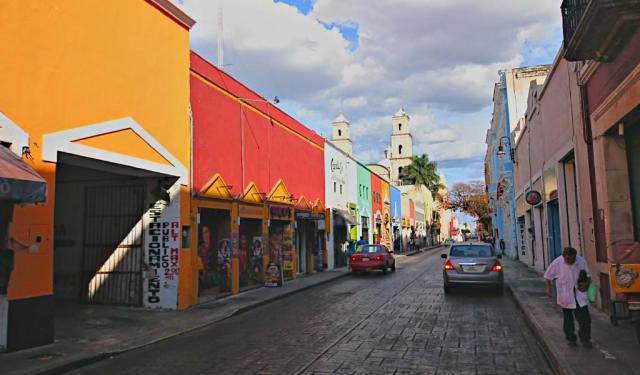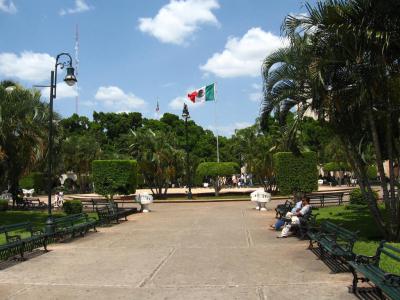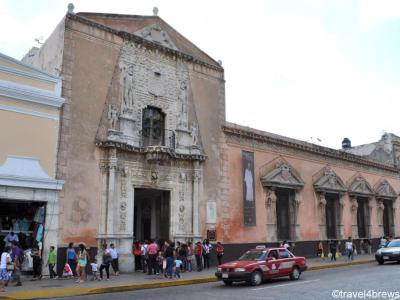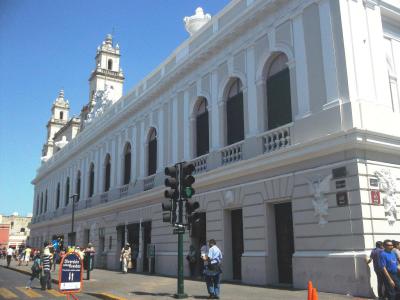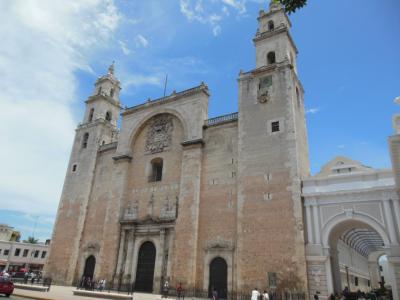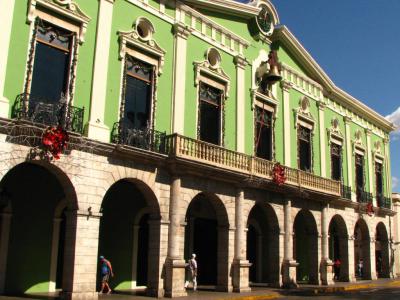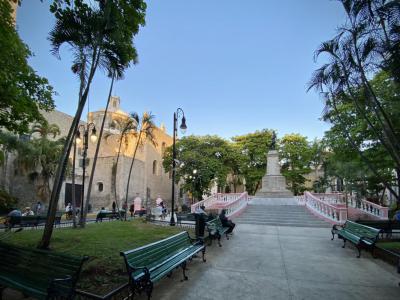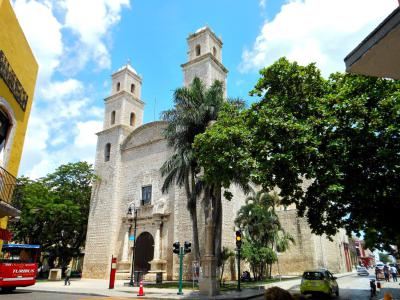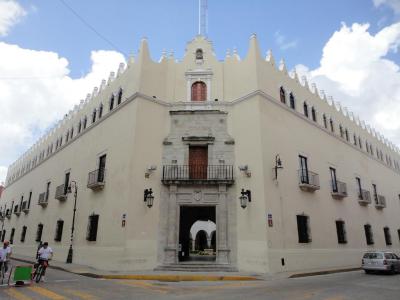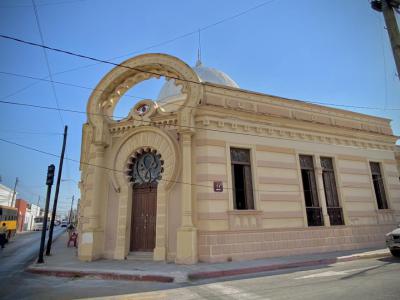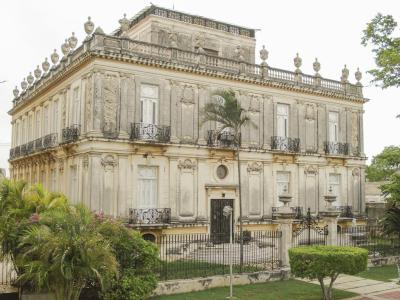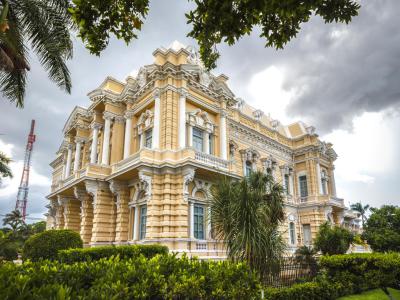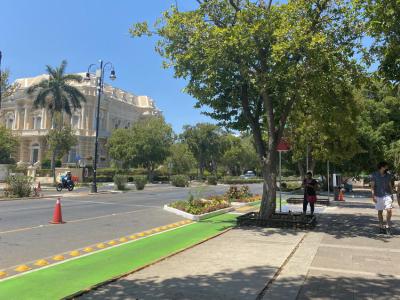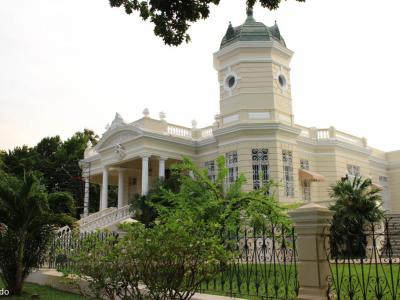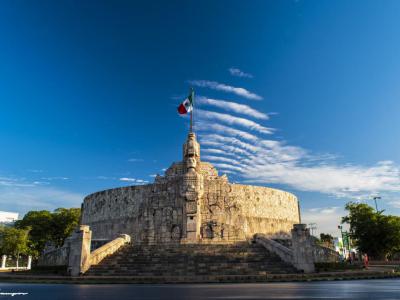Merida Introduction Walking Tour (Self Guided), Merida
When Spanish explorers arrived in the Yucatán in the 16th century, they stood among the ruins of T’ho, a Maya ceremonial city of pyramids and plazas. The massive stone temples reminded them of the Roman ruins in Merida, Spain, so they named their new settlement after it. That choice of name reflected a desire to link this place to the grandeur of Europe, but beneath the streets of the new Merida lay centuries of Maya history. T’ho tied local people to their gods and to the wider trade networks of the region.
Spanish conquistador Montejo the Younger formally founded Mérida in 1542, building the city directly on top of Maya foundations. The newcomers dismantled pyramids to reuse the stone, raising churches and homes in their place. Above all was the Mérida Cathedral, which still dominates the Main Square today. This cathedral, completed in the late 16th century, is one of the oldest in the Americas. The new city was laid out in a grid pattern typical of Spanish colonial towns, with the central square flanked by the cathedral, government palace, and residences of the colonial elite.
During the colonial period, Merida developed as an isolated outpost of New Spain. Separated from Mexico City by dense jungles, it connected more closely by sea to Havana, the capital of Cuba. Agriculture sustained the town, but the true transformation came centuries later with the henequen boom of the 19th century. This agave plant, used to make rope, became known as “green gold” and brought extraordinary wealth to Yucatán.
Yet the prosperity came with deep inequality: Maya laborers endured debt peonage, harsh working conditions, and the loss of their ancestral lands. Resentment built over decades, until in 1847 it erupted into the Caste War of Yucatán. The conflict dragged on until 1915, leaving long-lasting scars in the social fabric.
In the 20th century, the decline of henequen forced Merida to shift toward education, culture, and later tourism. Nowadays, it draws visitors with its colonial architecture, Maya heritage, and vibrant festivals. Merida is seen as both the cultural capital of the Yucatán and a gateway to nearby archaeological sites like Chichén Itzá and Uxmal.
As you walk through Merida, you’ll feel layers of history beneath your feet-the echo of Maya rituals, the clang of Spanish conquest, the hum of henequen wealth. Every plaza, every façade, every cobblestone whispers a piece of the city’s past.
Spanish conquistador Montejo the Younger formally founded Mérida in 1542, building the city directly on top of Maya foundations. The newcomers dismantled pyramids to reuse the stone, raising churches and homes in their place. Above all was the Mérida Cathedral, which still dominates the Main Square today. This cathedral, completed in the late 16th century, is one of the oldest in the Americas. The new city was laid out in a grid pattern typical of Spanish colonial towns, with the central square flanked by the cathedral, government palace, and residences of the colonial elite.
During the colonial period, Merida developed as an isolated outpost of New Spain. Separated from Mexico City by dense jungles, it connected more closely by sea to Havana, the capital of Cuba. Agriculture sustained the town, but the true transformation came centuries later with the henequen boom of the 19th century. This agave plant, used to make rope, became known as “green gold” and brought extraordinary wealth to Yucatán.
Yet the prosperity came with deep inequality: Maya laborers endured debt peonage, harsh working conditions, and the loss of their ancestral lands. Resentment built over decades, until in 1847 it erupted into the Caste War of Yucatán. The conflict dragged on until 1915, leaving long-lasting scars in the social fabric.
In the 20th century, the decline of henequen forced Merida to shift toward education, culture, and later tourism. Nowadays, it draws visitors with its colonial architecture, Maya heritage, and vibrant festivals. Merida is seen as both the cultural capital of the Yucatán and a gateway to nearby archaeological sites like Chichén Itzá and Uxmal.
As you walk through Merida, you’ll feel layers of history beneath your feet-the echo of Maya rituals, the clang of Spanish conquest, the hum of henequen wealth. Every plaza, every façade, every cobblestone whispers a piece of the city’s past.
How it works: Download the app "GPSmyCity: Walks in 1K+ Cities" from Apple App Store or Google Play Store to your mobile phone or tablet. The app turns your mobile device into a personal tour guide and its built-in GPS navigation functions guide you from one tour stop to next. The app works offline, so no data plan is needed when traveling abroad.
Merida Introduction Walking Tour Map
Guide Name: Merida Introduction Walking Tour
Guide Location: Mexico » Merida (See other walking tours in Merida)
Guide Type: Self-guided Walking Tour (Sightseeing)
# of Attractions: 14
Tour Duration: 2 Hour(s)
Travel Distance: 3.4 Km or 2.1 Miles
Author: DanaOffice
Sight(s) Featured in This Guide:
Guide Location: Mexico » Merida (See other walking tours in Merida)
Guide Type: Self-guided Walking Tour (Sightseeing)
# of Attractions: 14
Tour Duration: 2 Hour(s)
Travel Distance: 3.4 Km or 2.1 Miles
Author: DanaOffice
Sight(s) Featured in This Guide:
- Plaza Mayor (Main Square)
- Casa de los Montejo (Montejo House)
- Ateneo de Yucatán and Museum of Contemporary Art
- Cathedral of Mérida (Cathedral of Merida)
- El Palacio de Gobierno (Government Palace)
- Hidalgo Park
- Church of the Third Order of Jesus
- Autonomous University of Yucatan Central Building
- Casa Morisca (Moorish House)
- Las Casas Cámara (Cámara Houses)
- Canton Palace and Yucatan Regional Museum of Anthropology
- Paseo de Montejo (Montejo Walk)
- Quinta Montes Molina House Museum
- Monumento a la Patria (Monument to the Homeland)
1) Plaza Mayor (Main Square) (must see)
The Main Square, a gem among plazas in Mexico, offers a captivating blend of natural beauty, historical significance, and vibrant cultural activity. The plaza's grandeur is framed by majestic laurel trees, their sprawling branches providing welcome shade for park benches and expansive sidewalks. But Plaza Grande is more than just a picturesque setting; it carries with it a profound historical legacy.
In ancient times, this plaza was the heart of T'ho, serving as both a religious and social center for the indigenous people. With the arrival of the Spanish, it transformed into the Plaza de Armas, a parade ground, meticulously planned by Francisco de Montejo (the Younger). Today, it remains a hub of civic life, bearing witness to centuries of transformation and evolution.
One of the daily highlights at Main Square is the solemn ceremony of raising and lowering the Mexican flag, a poignant reminder of the nation's enduring spirit. Sundays bring an enchanting crafts market that adds a burst of color and creativity to the square. And nearly every night, the plaza comes alive with dance performances and live music, casting a spell of enchantment over all who gather here.
Throughout its storied history, Main Square has been an integral part of Merida's political, ecclesiastical, and civil life. It has borne witness to significant events, including the execution of indigenous leader Jacinto Canek and the struggles of the Federalists. The plaza has seen the rise and fall of regimes, the ebb and flow of cultural expression, and the resilient spirit of the people.
Over the years, Main Square has evolved and adapted. In 1871, it underwent a modest expansion, becoming a focal point for the city's urban transport, with tram lines radiating from its center. In 1886-1889, a two-story kiosk for musicians was added, becoming a hub for musical performances. In 1915, the square underwent restoration, removing political signs and introducing an octagonal central platform, binary seating, and lush shrubbery. In 1959, a new lighting system illuminated the plaza, enhancing its nighttime allure.
In ancient times, this plaza was the heart of T'ho, serving as both a religious and social center for the indigenous people. With the arrival of the Spanish, it transformed into the Plaza de Armas, a parade ground, meticulously planned by Francisco de Montejo (the Younger). Today, it remains a hub of civic life, bearing witness to centuries of transformation and evolution.
One of the daily highlights at Main Square is the solemn ceremony of raising and lowering the Mexican flag, a poignant reminder of the nation's enduring spirit. Sundays bring an enchanting crafts market that adds a burst of color and creativity to the square. And nearly every night, the plaza comes alive with dance performances and live music, casting a spell of enchantment over all who gather here.
Throughout its storied history, Main Square has been an integral part of Merida's political, ecclesiastical, and civil life. It has borne witness to significant events, including the execution of indigenous leader Jacinto Canek and the struggles of the Federalists. The plaza has seen the rise and fall of regimes, the ebb and flow of cultural expression, and the resilient spirit of the people.
Over the years, Main Square has evolved and adapted. In 1871, it underwent a modest expansion, becoming a focal point for the city's urban transport, with tram lines radiating from its center. In 1886-1889, a two-story kiosk for musicians was added, becoming a hub for musical performances. In 1915, the square underwent restoration, removing political signs and introducing an octagonal central platform, binary seating, and lush shrubbery. In 1959, a new lighting system illuminated the plaza, enhancing its nighttime allure.
2) Casa de los Montejo (Montejo House)
Montejo House, situated on the southern side of Plaza Grande in Merida, Mexico, is a historic gem with a rich and intriguing history dating back to 1540. Originally constructed to accommodate soldiers, it underwent a transformation into a grand mansion that would serve the distinguished members of the Montejo family for several centuries, finally transitioning to its present role in the 1800s.
Today, Montejo House wears multiple hats as it houses both a bank and a captivating museum. Visitors can explore its hallowed halls and immerse themselves in a permanent exhibition that showcases meticulously restored Victorian, neo-rococo, and neo-renaissance furnishings, all of which have been lovingly preserved within this venerable edifice.
As you approach the museum, take a moment to admire the intricately adorned facade. Here, you'll encounter statues of triumphant conquistadors brandishing halberds, seemingly perched triumphantly atop the heads of their vanquished adversaries. While these depictions may not specifically represent the Maya civilization, they are reminiscent of the era's colonial statuary, which often featured conquering figures of considerable stature overshadowing smaller indigenous individuals. This symbolism can also be observed in various churches throughout the region, where imposing priests stand prominently before or above diminutive indigenous figures.
Moreover, as you gaze out across Plaza Grande from the museum's facade, you'll encounter the dignified busts of Montejo the Elder, his wife, and his daughter. These sculpted tributes pay homage to the enduring legacy of the Montejo family, whose history is deeply intertwined with the captivating narrative of this remarkable building.
Today, Montejo House wears multiple hats as it houses both a bank and a captivating museum. Visitors can explore its hallowed halls and immerse themselves in a permanent exhibition that showcases meticulously restored Victorian, neo-rococo, and neo-renaissance furnishings, all of which have been lovingly preserved within this venerable edifice.
As you approach the museum, take a moment to admire the intricately adorned facade. Here, you'll encounter statues of triumphant conquistadors brandishing halberds, seemingly perched triumphantly atop the heads of their vanquished adversaries. While these depictions may not specifically represent the Maya civilization, they are reminiscent of the era's colonial statuary, which often featured conquering figures of considerable stature overshadowing smaller indigenous individuals. This symbolism can also be observed in various churches throughout the region, where imposing priests stand prominently before or above diminutive indigenous figures.
Moreover, as you gaze out across Plaza Grande from the museum's facade, you'll encounter the dignified busts of Montejo the Elder, his wife, and his daughter. These sculpted tributes pay homage to the enduring legacy of the Montejo family, whose history is deeply intertwined with the captivating narrative of this remarkable building.
3) Ateneo de Yucatán and Museum of Contemporary Art
The Fernando García Ponce Museum, also known as MACAY, serves as a vibrant showcase for Mexican artistic talent, featuring an array of national and international artists. It not only celebrates the work of these creators but also fosters a dynamic dialogue between local and foreign artists.
Nestled in the heart of Mérida's historic center, adjacent to the iconic Yucatán Cathedral, the museum occupies a building of immense historical significance. Originally known as the Athenaeum, the museum's name pays homage to its historical roots. Construction of this structure commenced between 1573 and 1579 under the auspices of Fray Diego de Landa, the Bishop of the Yucatán province. However, it wasn't until the episcopacy of Fray Gonzalo Salazar (1608 - 1636) that the building was completed and dedicated as the Archbishop's Palace.
The architectural evolution of this building mirrors the passage of time. Initially characterized by Franciscan simplicity and limited to a single story, it gradually transformed into its present-day incarnation, showcasing elegant French neoclassical design elements.
Throughout its storied history, the building served various purposes, including housing the chapels of San José and the Holy Rosary during the 17th century. Later, it became the Conciliar Seminary of Our Lady of the Rosary and San Ildefonso. In the 20th century, during General Salvador Alvarado's administration in 1916, the building was separated from the Cathedral, and the Passage of the Revolution, a striking iron and glass-roofed corridor connecting the two structures, was erected. Unfortunately, this passage was later dismantled.
General Salvador Alvarado transformed the building into an Athenaeum, offering the local population access to music, literature, and drawing classes, while also serving official purposes. However, it wasn't until 1993, during the governorship of Dulce María Sauri Riancho, that the building underwent a remarkable renaissance. Rescued from serious disrepair, the building was meticulously restored, and the museum was inaugurated in 1994.
Nestled in the heart of Mérida's historic center, adjacent to the iconic Yucatán Cathedral, the museum occupies a building of immense historical significance. Originally known as the Athenaeum, the museum's name pays homage to its historical roots. Construction of this structure commenced between 1573 and 1579 under the auspices of Fray Diego de Landa, the Bishop of the Yucatán province. However, it wasn't until the episcopacy of Fray Gonzalo Salazar (1608 - 1636) that the building was completed and dedicated as the Archbishop's Palace.
The architectural evolution of this building mirrors the passage of time. Initially characterized by Franciscan simplicity and limited to a single story, it gradually transformed into its present-day incarnation, showcasing elegant French neoclassical design elements.
Throughout its storied history, the building served various purposes, including housing the chapels of San José and the Holy Rosary during the 17th century. Later, it became the Conciliar Seminary of Our Lady of the Rosary and San Ildefonso. In the 20th century, during General Salvador Alvarado's administration in 1916, the building was separated from the Cathedral, and the Passage of the Revolution, a striking iron and glass-roofed corridor connecting the two structures, was erected. Unfortunately, this passage was later dismantled.
General Salvador Alvarado transformed the building into an Athenaeum, offering the local population access to music, literature, and drawing classes, while also serving official purposes. However, it wasn't until 1993, during the governorship of Dulce María Sauri Riancho, that the building underwent a remarkable renaissance. Rescued from serious disrepair, the building was meticulously restored, and the museum was inaugurated in 1994.
4) Cathedral of Mérida (Cathedral of Merida) (must see)
The Cathedral of Mérida stands as a magnificent testament to both the grandeur of Spanish colonial architecture and the rich history of Yucatán. Its construction, initiated in 1561 and completed in 1598, marked a significant milestone in the colonial era, making it the second cathedral to grace the Americas, following the Cathedral of Santo Domingo in 1550.
This architectural marvel, steeped in history, draws inspiration from Andalusia, with a design reminiscent of Spanish cathedrals. As the seat of the bishopric of Yucatán, it occupies a sacred space that was once home to Mayan ruins in T'ho, adding layers of significance to its foundations.
A defining feature of the cathedral is its remarkable system of vaulting, a structural innovation influenced by the ideas of the Spanish architect Andres de Vandelvira. This innovative vaulting system, derived from Vandelvira's work on the Cathedral of Jaén, showcases the cathedral's commitment to blending European design principles with New World ambitions. Notably, it is believed that the plans and concepts of Vandelvira were introduced to the Mérida project by the first bishop of Yucatán, fray Francisco Toral, himself hailing from Ubeda in the Jaén province.
References to the cathedral's presence can even be found in the ancient Books of Chilam Balam, underscoring its deep-rooted connection to the region's history and spirituality.
The cathedral's facade, adorned with intricate details, once displayed the Spanish royal coat of arms, featuring gold castles and crowned lions-a symbol of Spain's monarchs. At its pinnacle, a representation of the royal crown of Spain proudly adorned the crest. However, the winds of change brought by Mexico's independence stirred anti-Spanish sentiment, leading to the partial destruction of the shield. The central elements, housing the castles and lions, were chiseled away in symbolic defiance. In 1824, the void left behind was transformed, as a Mexican eagle, wearing the imperial crown of Iturbide.
The facade of the cathedral is graced by statues of Saint Peter and Saint Paul. Saint Paul, recognized by the sword and book he holds, stands in honor of his apostolic role. Saint Peter, meanwhile, is depicted clutching the keys to the Church, symbolizing his spiritual authority.
This architectural marvel, steeped in history, draws inspiration from Andalusia, with a design reminiscent of Spanish cathedrals. As the seat of the bishopric of Yucatán, it occupies a sacred space that was once home to Mayan ruins in T'ho, adding layers of significance to its foundations.
A defining feature of the cathedral is its remarkable system of vaulting, a structural innovation influenced by the ideas of the Spanish architect Andres de Vandelvira. This innovative vaulting system, derived from Vandelvira's work on the Cathedral of Jaén, showcases the cathedral's commitment to blending European design principles with New World ambitions. Notably, it is believed that the plans and concepts of Vandelvira were introduced to the Mérida project by the first bishop of Yucatán, fray Francisco Toral, himself hailing from Ubeda in the Jaén province.
References to the cathedral's presence can even be found in the ancient Books of Chilam Balam, underscoring its deep-rooted connection to the region's history and spirituality.
The cathedral's facade, adorned with intricate details, once displayed the Spanish royal coat of arms, featuring gold castles and crowned lions-a symbol of Spain's monarchs. At its pinnacle, a representation of the royal crown of Spain proudly adorned the crest. However, the winds of change brought by Mexico's independence stirred anti-Spanish sentiment, leading to the partial destruction of the shield. The central elements, housing the castles and lions, were chiseled away in symbolic defiance. In 1824, the void left behind was transformed, as a Mexican eagle, wearing the imperial crown of Iturbide.
The facade of the cathedral is graced by statues of Saint Peter and Saint Paul. Saint Paul, recognized by the sword and book he holds, stands in honor of his apostolic role. Saint Peter, meanwhile, is depicted clutching the keys to the Church, symbolizing his spiritual authority.
5) El Palacio de Gobierno (Government Palace)
Nestled in the heart of Mérida, the Government Palace is an architectural gem that not only serves as the seat of the state government of Yucatán but also stands as a living testament to the region's rich history and cultural heritage. This magnificent edifice, built in 1892, beckons visitors with its impressive façade and beckons them to explore the captivating world within.
As you step into the Government Palace, you are immediately greeted by an extraordinary collection of murals and oil paintings created by the gifted local artist, Fernando Castro Pacheco. These masterpieces adorn the splendid sala, or hall, and weave together a vivid and symbolic tapestry of the Maya civilization and their intricate relationship with the Spanish conquistadors.
The artworks within the Government Palace do much more than capture the eye; they tell a story. This story is one of the Maya people, their resilience, and their profound connection with the land they call home. It is a narrative of their interactions with the Spaniards, a pivotal chapter in the history of the Yucatán Peninsula.
As you step into the Government Palace, you are immediately greeted by an extraordinary collection of murals and oil paintings created by the gifted local artist, Fernando Castro Pacheco. These masterpieces adorn the splendid sala, or hall, and weave together a vivid and symbolic tapestry of the Maya civilization and their intricate relationship with the Spanish conquistadors.
The artworks within the Government Palace do much more than capture the eye; they tell a story. This story is one of the Maya people, their resilience, and their profound connection with the land they call home. It is a narrative of their interactions with the Spaniards, a pivotal chapter in the history of the Yucatán Peninsula.
6) Hidalgo Park
Hidalgo Park, formerly known as Manuel Cepeda Peraza park, is a historical gem nestled in the heart of Mérida. Its rich history traces back to the mid-19th century when it graced the city as a charming square adorned with a graceful fountain. In 1877, the park underwent a transformation and was christened Parque Hidalgo, paying homage to the revered Don Miguel Hidalgo y Costilla. However, in 1896, it saw another name change, becoming Parque Cepeda Peraza.
Despite its various name changes, Parque Hidalgo, as it's affectionately known, remains a beloved spot that offers a genuine glimpse into the pulse of the city. This lush green oasis is adorned with graceful almond trees, creating an inviting space where visitors can seek respite from the sun or simply unwind.
This park is more than just a peaceful retreat; it's also a vibrant hub of local activity. On Thursdays, local artisans set up shop here, providing an excellent opportunity to engage in people-watching, strike up conversations with talented craftsmen, and perhaps even acquire a unique, handcrafted souvenir.
Despite its various name changes, Parque Hidalgo, as it's affectionately known, remains a beloved spot that offers a genuine glimpse into the pulse of the city. This lush green oasis is adorned with graceful almond trees, creating an inviting space where visitors can seek respite from the sun or simply unwind.
This park is more than just a peaceful retreat; it's also a vibrant hub of local activity. On Thursdays, local artisans set up shop here, providing an excellent opportunity to engage in people-watching, strike up conversations with talented craftsmen, and perhaps even acquire a unique, handcrafted souvenir.
7) Church of the Third Order of Jesus
The Church of the Third Order of Jesus, located just north of Parque Hidalgo, stands as one of the city's oldest and historically significant landmarks. It holds the distinction of being the first Jesuit church in the Yucatán region, with a rich history dating back to its construction in 1618.
This venerable structure was crafted using limestone blocks salvaged from a dismantled Maya temple, infusing it with a unique blend of colonial and indigenous architectural elements. Remarkably, faint traces of ancient carvings from the Maya era still adorn the church's west wall, offering a tangible connection to the region's rich pre-Columbian history.
While the Church of the Third Order of Jesus is often chosen as a venue for society weddings, its interior is characterized by simplicity rather than ornate embellishments. The unadorned yet evocative ambiance within the church's walls provides a sense of serenity and historical resonance.
The building's historical legacy extends beyond the church itself, as the former convent rooms at the rear of the complex have been repurposed to house the Pinoteca Juan Gamboa Guzmán. This small yet captivating art collection is a hidden gem within the church's precincts. Among its notable exhibits are the striking bronze sculptures crafted by the celebrated 20th-century artist Enrique Gottdiener Soto, which pay homage to the indigenous Maya culture.
Venturing to the second floor of the museum reveals a selection of approximately 20 oil paintings, most of which depict past civic officials. While these may not be the museum's most memorable offerings, they serve as an additional thread in the tapestry of the church's historical narrative.
This venerable structure was crafted using limestone blocks salvaged from a dismantled Maya temple, infusing it with a unique blend of colonial and indigenous architectural elements. Remarkably, faint traces of ancient carvings from the Maya era still adorn the church's west wall, offering a tangible connection to the region's rich pre-Columbian history.
While the Church of the Third Order of Jesus is often chosen as a venue for society weddings, its interior is characterized by simplicity rather than ornate embellishments. The unadorned yet evocative ambiance within the church's walls provides a sense of serenity and historical resonance.
The building's historical legacy extends beyond the church itself, as the former convent rooms at the rear of the complex have been repurposed to house the Pinoteca Juan Gamboa Guzmán. This small yet captivating art collection is a hidden gem within the church's precincts. Among its notable exhibits are the striking bronze sculptures crafted by the celebrated 20th-century artist Enrique Gottdiener Soto, which pay homage to the indigenous Maya culture.
Venturing to the second floor of the museum reveals a selection of approximately 20 oil paintings, most of which depict past civic officials. While these may not be the museum's most memorable offerings, they serve as an additional thread in the tapestry of the church's historical narrative.
8) Autonomous University of Yucatan Central Building
The Autonomous University of Yucatán, UADY, boasts several campus buildings strategically located throughout Mérida. However, the most renowned among them, especially for enthusiasts of colonial architecture, is the illustrious Central Building.
This historic edifice dates back to the early 17th century when it was commissioned under the authority of King Philip III of Spain in 1611. After several years of construction, it was proudly inaugurated in 1618. The Central Building, with its expansive, gleaming white façade, stands as a magnificent exemplar of colonial-era architecture.
At the heart of this sprawling structure lies a central courtyard, which has witnessed a fascinating transformation over the years. Today, the graceful balcony arches adorning its perimeter evoke echoes of Spanish Moorish architectural influences. On Friday nights, this courtyard serves as a vibrant stage for dance recitals, courtesy of the university's esteemed Ballet Folklorico.
Yet, what truly distinguishes the UADY Central Building is its iconic recessed corner entranceway. This distinctive architectural feature has become a symbol of both the university's rich history and its enduring commitment to education and culture.
As a testament to its enduring legacy and architectural significance, the Autonomous University of Yucatán's Central Building stands as a cherished cultural landmark, embodying the harmonious blend of history, academia, and artistic expression in the heart of Mérida.
This historic edifice dates back to the early 17th century when it was commissioned under the authority of King Philip III of Spain in 1611. After several years of construction, it was proudly inaugurated in 1618. The Central Building, with its expansive, gleaming white façade, stands as a magnificent exemplar of colonial-era architecture.
At the heart of this sprawling structure lies a central courtyard, which has witnessed a fascinating transformation over the years. Today, the graceful balcony arches adorning its perimeter evoke echoes of Spanish Moorish architectural influences. On Friday nights, this courtyard serves as a vibrant stage for dance recitals, courtesy of the university's esteemed Ballet Folklorico.
Yet, what truly distinguishes the UADY Central Building is its iconic recessed corner entranceway. This distinctive architectural feature has become a symbol of both the university's rich history and its enduring commitment to education and culture.
As a testament to its enduring legacy and architectural significance, the Autonomous University of Yucatán's Central Building stands as a cherished cultural landmark, embodying the harmonious blend of history, academia, and artistic expression in the heart of Mérida.
9) Casa Morisca (Moorish House)
Casa Morisca, also known as the Moorish House, is a captivating architectural gem nestled in the heart of Merida, Mexico. This remarkable residence, constructed in 1909, has a storied history marked by periods of neglect and painstaking restoration.
Originally commissioned by Genaro Pérez y Santos, a merchant hailing from Pontevedra, Spain, Casa Morisca was intended to be a shared abode with his Yucatecan wife, María Alzina. Genaro and his brother Federico, both traders, along with José María Pino Domínguez, went on to establish a carbonated water company-a testament to their entrepreneurial spirit.
The distinctive Casa Morisca boasts 24 rooms and showcases a unique blend of French and Moorish architectural styles, which immediately set it apart. During the 1920s, it served as the United States Consulate, and in the 1930s, it transformed into a maternity hospital, embodying its adaptive nature over the years.
Intriguingly, this historic house even played a role in the world of cinema when scenes from the 1977 movie "La Casta Divina" were filmed within its walls. At that time, the Chapur family was among its notable owners.
In 1991, architect Eduardo Millet Cámara undertook a comprehensive restoration, breathing new vitality into Casa Morisca. Fast forward to 2017 when the property changed hands once more, and this transition marked the beginning of a gradual renovation and expansion process. While the original building is steeped in intricate Moorish and French architectural details, the newer section adopts a contrasting modernistic design.
Originally commissioned by Genaro Pérez y Santos, a merchant hailing from Pontevedra, Spain, Casa Morisca was intended to be a shared abode with his Yucatecan wife, María Alzina. Genaro and his brother Federico, both traders, along with José María Pino Domínguez, went on to establish a carbonated water company-a testament to their entrepreneurial spirit.
The distinctive Casa Morisca boasts 24 rooms and showcases a unique blend of French and Moorish architectural styles, which immediately set it apart. During the 1920s, it served as the United States Consulate, and in the 1930s, it transformed into a maternity hospital, embodying its adaptive nature over the years.
Intriguingly, this historic house even played a role in the world of cinema when scenes from the 1977 movie "La Casta Divina" were filmed within its walls. At that time, the Chapur family was among its notable owners.
In 1991, architect Eduardo Millet Cámara undertook a comprehensive restoration, breathing new vitality into Casa Morisca. Fast forward to 2017 when the property changed hands once more, and this transition marked the beginning of a gradual renovation and expansion process. While the original building is steeped in intricate Moorish and French architectural details, the newer section adopts a contrasting modernistic design.
10) Las Casas Cámara (Cámara Houses)
The Cámara Houses, also known as the Twin Houses, are a pair of historic townhouses located in the charming city of Mérida. These houses are not just architectural marvels but also hold a rich history within their walls.
Constructed between 1908 and 1911, the Cámara Houses are a shining example of Beaux-Arts design in the elegant French Second Empire Style, thanks to the visionary French architect Gustave Umbdenstock. Initially, these houses were commissioned as a private residence for the distinguished de la Cámara family, who were part of the Yucatán aristocracy.
Intricately designed and exquisitely crafted, these houses stood as a testament to the opulence and grandeur of their time. Over the years, they have played host to a myriad of illustrious guests, adding to their mystique. The guest list includes luminaries such as Princess Grace and Prince Rainier of Monaco, Queen Juliana of the Netherlands, Umberto II of Italy, and even Jacqueline Kennedy Onassis.
In 1964, one of the two houses was acquired by the Barbachano family, marking a turning point in the houses' history. In 2021, this house has opened its doors to the public, transforming into a captivating museum.
Constructed between 1908 and 1911, the Cámara Houses are a shining example of Beaux-Arts design in the elegant French Second Empire Style, thanks to the visionary French architect Gustave Umbdenstock. Initially, these houses were commissioned as a private residence for the distinguished de la Cámara family, who were part of the Yucatán aristocracy.
Intricately designed and exquisitely crafted, these houses stood as a testament to the opulence and grandeur of their time. Over the years, they have played host to a myriad of illustrious guests, adding to their mystique. The guest list includes luminaries such as Princess Grace and Prince Rainier of Monaco, Queen Juliana of the Netherlands, Umberto II of Italy, and even Jacqueline Kennedy Onassis.
In 1964, one of the two houses was acquired by the Barbachano family, marking a turning point in the houses' history. In 2021, this house has opened its doors to the public, transforming into a captivating museum.
11) Canton Palace and Yucatan Regional Museum of Anthropology
Cantón Palace is a magnificent mansion that stands as a testament to an era of grandeur and ambition. This massive architectural marvel was constructed between 1909 and 1911, intended to be the residence of General Francisco Cantón Rosado (1833–1917), an influential figure of his time. However, General Cantón Rosado lived here for only a brief six years before his passing.
The opulence and grandiosity of Palacio Cantón make it a fitting symbol of the lofty aspirations held by Merida's elite during the final years of the Porfiriato era. This period, spanning from 1876 to 1911, was marked by the authoritarian rule of Porfirio Díaz, who held significant power in Mexico.
The Regional Museum of Anthropology of Yucatán houses an extensive and vital collection that sheds light on the rich tapestry of the Yucatecan Mayan culture. Within its walls, you'll encounter a diverse array of artifacts and archaeological wonders, including stelae, intricately carved stones, sculptures, and samples of ceramics. These precious relics have, for the most part, been unearthed from the archaeological sites scattered across the Yucatán Peninsula. The museum's collection spans across various epochs, encompassing pieces from the preclassic period to the late postclassic period, offering a comprehensive view of the Mayan civilization's evolution.
The opulence and grandiosity of Palacio Cantón make it a fitting symbol of the lofty aspirations held by Merida's elite during the final years of the Porfiriato era. This period, spanning from 1876 to 1911, was marked by the authoritarian rule of Porfirio Díaz, who held significant power in Mexico.
The Regional Museum of Anthropology of Yucatán houses an extensive and vital collection that sheds light on the rich tapestry of the Yucatecan Mayan culture. Within its walls, you'll encounter a diverse array of artifacts and archaeological wonders, including stelae, intricately carved stones, sculptures, and samples of ceramics. These precious relics have, for the most part, been unearthed from the archaeological sites scattered across the Yucatán Peninsula. The museum's collection spans across various epochs, encompassing pieces from the preclassic period to the late postclassic period, offering a comprehensive view of the Mayan civilization's evolution.
12) Paseo de Montejo (Montejo Walk) (must see)
Montejo Walk bears a name steeped in history and significance. Named after Francisco de Montejo, the renowned conqueror of Yucatán and the visionary founder of the capital city of Yucatán, this avenue weaves together the past and present of this vibrant Mexican city.
Stretching from the Santa Ana neighborhood, nestled in the heart of Mérida, to the gateway leading to the port of Progreso in Yucatán, Montejo Walk is more than just a road; it is a lifeline that connects the city's historical core with its modern aspirations.
Montejo Walk is a vital artery lined with an array of public and private institutions, each playing a role in the rich tapestry of Mérida's life. The layout and design of this avenue draw inspiration from the grand boulevards of France, with a notable nod to the iconic Champs Elysées in Paris. Lined by stately trees, it features a central median and charming gazebos that provide a sense of elegance and serenity to the thoroughfare.
Along the length of Montejo Walk, you'll encounter an array of important monuments and buildings that serve as iconic landmarks of Mérida and the state of Yucatán as a whole. This avenue, in essence, pays tribute to the legacy of Francisco de Montejo y León (the Mozo), commemorating his role as the founder of Mérida and his enduring impact on the region.
Stretching from the Santa Ana neighborhood, nestled in the heart of Mérida, to the gateway leading to the port of Progreso in Yucatán, Montejo Walk is more than just a road; it is a lifeline that connects the city's historical core with its modern aspirations.
Montejo Walk is a vital artery lined with an array of public and private institutions, each playing a role in the rich tapestry of Mérida's life. The layout and design of this avenue draw inspiration from the grand boulevards of France, with a notable nod to the iconic Champs Elysées in Paris. Lined by stately trees, it features a central median and charming gazebos that provide a sense of elegance and serenity to the thoroughfare.
Along the length of Montejo Walk, you'll encounter an array of important monuments and buildings that serve as iconic landmarks of Mérida and the state of Yucatán as a whole. This avenue, in essence, pays tribute to the legacy of Francisco de Montejo y León (the Mozo), commemorating his role as the founder of Mérida and his enduring impact on the region.
13) Quinta Montes Molina House Museum
Quinta Montes Molina House Museum is a splendid example of eclectic architecture with a distinct European neoclassical influence. This elegant mansion, which dates back to the early 20th century during the Mexican Porfiriato era, has found a new lease on life as a house museum, offering visitors a glimpse into its rich history and the lifestyle of its era. It stands proudly among the most representative European-style buildings in the region, sharing the spotlight with other grand residences like the Cantón Palace and the Twin Houses.
What sets the Casa Museo apart is its exceptional preservation in its original state. As you step inside, you are transported back in time to experience how families in the city lived during that bygone era. The construction of this magnificent house was completed around 1902, and it has been a cherished part of the Montes Molina family since 1915. Remarkably, the house has retained all of its original furniture, lovingly preserved through the four generations that have called it home.
Beyond its historical significance, Quinta Montes Molina also offers visitors the opportunity to explore a curated collection of high-quality regional handicrafts in its on-site store.
What sets the Casa Museo apart is its exceptional preservation in its original state. As you step inside, you are transported back in time to experience how families in the city lived during that bygone era. The construction of this magnificent house was completed around 1902, and it has been a cherished part of the Montes Molina family since 1915. Remarkably, the house has retained all of its original furniture, lovingly preserved through the four generations that have called it home.
Beyond its historical significance, Quinta Montes Molina also offers visitors the opportunity to explore a curated collection of high-quality regional handicrafts in its on-site store.
14) Monumento a la Patria (Monument to the Homeland)
The Monument to the Homeland, sculpted entirely by hand, is a symbol of pride and a unique marvel located on the grand Paseo de Montejo Avenue.
Crafted in the mid-20th century by the skilled Colombian sculptor Rómulo Rozo, the Monument to the Homeland holds a special place in the hearts of the people of Mérida. It distinguishes itself as the sole structure in the world carved entirely directly into stone, making it an exceptional work of art and engineering.
The journey of creating this iconic monument commenced on March 7, 1945, under the visionary guidance of Rómulo Rozo, in collaboration with the architect Manuel Amábilis Domínguez, his son Max Amábilis, and the master builder Víctor Nazario Ojeda. Originally conceived to honor the Mexican flag, it was later decided that the monument should encompass a comprehensive visual narrative of Mexico's history, a truly ambitious undertaking that sets it apart from others in the country.
Due to the intricacy and scale of this monumental endeavor, construction spanned an impressive 11 years, culminating in its completion in 1956. On April 23 of that year, the Monument to the Homeland was officially inaugurated by the President of Mexico at the time, Adolfo Ruiz Cortines, marking a momentous occasion in Mexican history.
In 2016, the International Bureau of Cultural Capitals bestowed upon the Monument to the Homeland the honor of being recognized as one of the Cultural Treasures of Mérida and a cultural emblem of humanity.
Crafted in the mid-20th century by the skilled Colombian sculptor Rómulo Rozo, the Monument to the Homeland holds a special place in the hearts of the people of Mérida. It distinguishes itself as the sole structure in the world carved entirely directly into stone, making it an exceptional work of art and engineering.
The journey of creating this iconic monument commenced on March 7, 1945, under the visionary guidance of Rómulo Rozo, in collaboration with the architect Manuel Amábilis Domínguez, his son Max Amábilis, and the master builder Víctor Nazario Ojeda. Originally conceived to honor the Mexican flag, it was later decided that the monument should encompass a comprehensive visual narrative of Mexico's history, a truly ambitious undertaking that sets it apart from others in the country.
Due to the intricacy and scale of this monumental endeavor, construction spanned an impressive 11 years, culminating in its completion in 1956. On April 23 of that year, the Monument to the Homeland was officially inaugurated by the President of Mexico at the time, Adolfo Ruiz Cortines, marking a momentous occasion in Mexican history.
In 2016, the International Bureau of Cultural Capitals bestowed upon the Monument to the Homeland the honor of being recognized as one of the Cultural Treasures of Mérida and a cultural emblem of humanity.
The Most Popular Cities
/ view all
